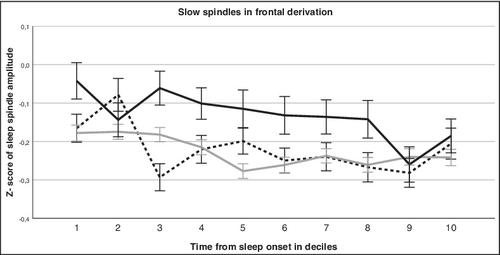当前位置:
X-MOL 学术
›
Genes Brain Behav.
›
论文详情
Our official English website, www.x-mol.net, welcomes your feedback! (Note: you will need to create a separate account there.)
Polygenic impact of morningness on the overnight dynamics of sleep spindle amplitude.
Genes, Brain and Behavior ( IF 2.5 ) Pub Date : 2020-01-17 , DOI: 10.1111/gbb.12641 Anu-Katriina Pesonen 1 , Ilona Merikanto 1, 2 , Risto Halonen 1 , Peter Ujma 3, 4 , Tommi Makkonen 5 , Katri Räikkönen 5 , Jari Lahti 5 , Liisa Kuula 1
Genes, Brain and Behavior ( IF 2.5 ) Pub Date : 2020-01-17 , DOI: 10.1111/gbb.12641 Anu-Katriina Pesonen 1 , Ilona Merikanto 1, 2 , Risto Halonen 1 , Peter Ujma 3, 4 , Tommi Makkonen 5 , Katri Räikkönen 5 , Jari Lahti 5 , Liisa Kuula 1
Affiliation

|
Sleep spindles are thalamocortical oscillations that contribute to sleep maintenance and sleep-related brain plasticity. The current study is an explorative study of the circadian dynamics of sleep spindles in relation to a polygenic score (PGS) for circadian preference towards morningness. The participants represent the 17-year follow-up of a birth cohort having both genome-wide data and an ambulatory sleep electroencephalography measurement available ( N = 154, Mean age = 16.9, SD = 0.1 years, 57% girls). Based on a recent genome-wide association study, we calculated a PGS for circadian preference towards morningness across the whole genome, including 354 single-nucleotide polymorphisms. Stage 2 slow (9-12.5 Hz, N = 186 739) and fast (12.5-16 Hz, N = 135 504) sleep spindles were detected using an automated algorithm with individual time tags and amplitudes for each spindle. There was a significant interaction of PGS for morningness and timing of sleep spindles across the night. These growth curve models showed a curvilinear trajectory of spindle amplitudes: those with a higher PGS for morningness showed higher slow spindle amplitudes in frontal derivations, and a faster dissipation of spindle amplitude in central derivations. Overall, the findings provide new evidence on how individual sleep spindle trajectories are influenced by genetic factors associated with circadian type. The finding may lead to new hypotheses on the associations previously observed between circadian types, psychiatric problems and spindle activity.
中文翻译:

早晨对睡眠纺锤幅度过夜动态的多基因影响。
睡眠纺锤体是丘脑皮质振荡,有助于维持睡眠和与睡眠有关的大脑可塑性。当前的研究是关于睡眠纺锤的昼夜节律动力学与昼夜节律对早晨的偏好的多基因评分(PGS)相关的探索性研究。参与者代表了一个出生队列的17年随访,该队列具有全基因组数据和动态睡眠脑电图测量结果(N = 154,平均年龄= 16.9,SD = 0.1岁,女孩占57%)。基于最近的全基因组关联研究,我们计算了昼夜节律对整个基因组的早晨偏好的PGS,包括354个单核苷酸多态性。第二阶段慢速(9-12.5 Hz,N = 186739)和快速(12.5-16 Hz,N = 135 504)使用自动算法检测睡眠纺锤,每个纺锤具有单独的时间标签和振幅。PGS在整个晚上的早晨和睡眠纺锤体的时间安排之间存在显着的相互作用。这些增长曲线模型显示了主轴振幅的曲线轨迹:早晨具有PGS较高的那些,在额叶派生中显示较高的慢主轴振幅,而在中心派生中显示更快的主轴振幅耗散。总的来说,这些发现提供了关于个体睡眠纺锤轨迹如何受与昼夜节律相关的遗传因素影响的新证据。该发现可能导致关于先前观察到的昼夜节律类型,精神病问题和纺锤体活动之间的关联的新假设。PGS在整个晚上的早晨和睡眠纺锤体的时间安排之间存在显着的相互作用。这些增长曲线模型显示了主轴振幅的曲线轨迹:早晨具有PGS较高的那些,在额叶派生中显示较高的慢主轴振幅,而在中心派生中显示更快的主轴振幅耗散。总的来说,这些发现提供了关于个体睡眠纺锤轨迹如何受到与昼夜节律类型相关的遗传因素影响的新证据。该发现可能导致关于先前观察到的昼夜节律类型,精神病问题和纺锤体活动之间的关联的新假设。PGS在整个晚上的早晨和睡眠纺锤体的时间安排之间存在显着的相互作用。这些增长曲线模型显示了主轴振幅的曲线轨迹:早晨具有PGS较高的那些,在额叶派生中显示较高的慢主轴振幅,而在中心派生中显示更快的主轴振幅耗散。总的来说,这些发现提供了关于个体睡眠纺锤轨迹如何受到与昼夜节律类型相关的遗传因素影响的新证据。该发现可能导致关于先前观察到的昼夜节律类型,精神病问题和纺锤体活动之间的关联的新假设。早晨PGS较高的人在额叶衍生中显示较高的慢纺锤幅度,而在中央衍生物中显示较快的纺锤幅度耗散。总的来说,这些发现提供了关于个体睡眠纺锤轨迹如何受到与昼夜节律类型相关的遗传因素影响的新证据。该发现可能导致关于先前观察到的昼夜节律类型,精神病问题和纺锤体活动之间的关联的新假设。早晨PGS较高的人在额叶衍生中显示较高的慢纺锤幅度,而在中央衍生物中显示较快的纺锤幅度耗散。总的来说,这些发现提供了关于个体睡眠纺锤轨迹如何受到与昼夜节律类型相关的遗传因素影响的新证据。该发现可能导致关于先前观察到的昼夜节律类型,精神病问题和纺锤体活动之间的关联的新假设。
更新日期:2020-01-17
中文翻译:

早晨对睡眠纺锤幅度过夜动态的多基因影响。
睡眠纺锤体是丘脑皮质振荡,有助于维持睡眠和与睡眠有关的大脑可塑性。当前的研究是关于睡眠纺锤的昼夜节律动力学与昼夜节律对早晨的偏好的多基因评分(PGS)相关的探索性研究。参与者代表了一个出生队列的17年随访,该队列具有全基因组数据和动态睡眠脑电图测量结果(N = 154,平均年龄= 16.9,SD = 0.1岁,女孩占57%)。基于最近的全基因组关联研究,我们计算了昼夜节律对整个基因组的早晨偏好的PGS,包括354个单核苷酸多态性。第二阶段慢速(9-12.5 Hz,N = 186739)和快速(12.5-16 Hz,N = 135 504)使用自动算法检测睡眠纺锤,每个纺锤具有单独的时间标签和振幅。PGS在整个晚上的早晨和睡眠纺锤体的时间安排之间存在显着的相互作用。这些增长曲线模型显示了主轴振幅的曲线轨迹:早晨具有PGS较高的那些,在额叶派生中显示较高的慢主轴振幅,而在中心派生中显示更快的主轴振幅耗散。总的来说,这些发现提供了关于个体睡眠纺锤轨迹如何受与昼夜节律相关的遗传因素影响的新证据。该发现可能导致关于先前观察到的昼夜节律类型,精神病问题和纺锤体活动之间的关联的新假设。PGS在整个晚上的早晨和睡眠纺锤体的时间安排之间存在显着的相互作用。这些增长曲线模型显示了主轴振幅的曲线轨迹:早晨具有PGS较高的那些,在额叶派生中显示较高的慢主轴振幅,而在中心派生中显示更快的主轴振幅耗散。总的来说,这些发现提供了关于个体睡眠纺锤轨迹如何受到与昼夜节律类型相关的遗传因素影响的新证据。该发现可能导致关于先前观察到的昼夜节律类型,精神病问题和纺锤体活动之间的关联的新假设。PGS在整个晚上的早晨和睡眠纺锤体的时间安排之间存在显着的相互作用。这些增长曲线模型显示了主轴振幅的曲线轨迹:早晨具有PGS较高的那些,在额叶派生中显示较高的慢主轴振幅,而在中心派生中显示更快的主轴振幅耗散。总的来说,这些发现提供了关于个体睡眠纺锤轨迹如何受到与昼夜节律类型相关的遗传因素影响的新证据。该发现可能导致关于先前观察到的昼夜节律类型,精神病问题和纺锤体活动之间的关联的新假设。早晨PGS较高的人在额叶衍生中显示较高的慢纺锤幅度,而在中央衍生物中显示较快的纺锤幅度耗散。总的来说,这些发现提供了关于个体睡眠纺锤轨迹如何受到与昼夜节律类型相关的遗传因素影响的新证据。该发现可能导致关于先前观察到的昼夜节律类型,精神病问题和纺锤体活动之间的关联的新假设。早晨PGS较高的人在额叶衍生中显示较高的慢纺锤幅度,而在中央衍生物中显示较快的纺锤幅度耗散。总的来说,这些发现提供了关于个体睡眠纺锤轨迹如何受到与昼夜节律类型相关的遗传因素影响的新证据。该发现可能导致关于先前观察到的昼夜节律类型,精神病问题和纺锤体活动之间的关联的新假设。



























 京公网安备 11010802027423号
京公网安备 11010802027423号